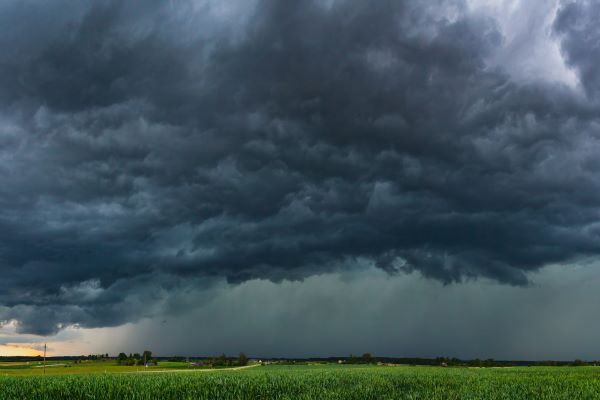June 9, 2025

Multi-Peril Crop Insurance (MPCI) policies have a prevented planting provision that might come in handy since 2025 is looking to be a wet planting season. Read on for more information, and as always, keep in touch with your local Crop Growers agent to see if prevented planting is something you should consider.
What is Prevented Planting?
Prevented planting is the failure to plant an insured crop with the proper equipment by the final planting date.
Why opt for prevented planting?
High input costs
Prices continue to increase for fuel, labor, fertilizer, etc. Unfortunately, commodity prices are stagnant and profit margins remain tight. By utilizing prevented planting, you aren’t wasting as much of those costly inputs.
Time
For example, let’s say it’s June 10 (the final plant date for corn and soybeans in much of the Northeast), the planting season has been wet and next week is showing rain again. If you plant after June 10, you lose 1% of your insurance guarantee per day. Why plant in the mud? You would be taking a risk on harvesting a marginal crop due to poor planting conditions, and less growing degree days.
Prevent equipment damage
Availability of necessary parts for repairs continues to be elusive for a lot of necessary machinery for planting. If you mud in your spring crop, you risk breaking your equipment. Who knows how long it could take to get a replacement part? And how much is that part going to cost you? By taking prevented planting, you can also prevent damage to your equipment.
Qualifications for a claim — read carefully before making your decision!
Weather
It MUST be a weather condition that prevents you and others in the area from planting crops. MPCI policies only cover naturally occurring perils. If Mother Nature decides to open her skies during planting season, it may be covered by your insurance policy. If your equipment breaks down or your farm hand doesn’t show up for work, that is not covered by your policy.
Prevented planting must be general in your area and this will be determined by the insurance company. Multiple prevented plant claims being opened in your county and weather data that can support the rainfall in your area are the only ways to determine if a prevented plant claim can be approved.
Eligible Acreage
The acreage that is prevented from being planted must meet certain eligibility requirements to qualify for a payment.
- Acreage must be available for planting and free of physical factors which prevent planting.
- Acreage must not have a perennial crop, pasture or forage crop in place.
- Acreage must have been planted, harvested and insured in 1 of the last 4 years.
- Acreage must not be enrolled in a USDA program that prevents planting.
**Any acreage not meeting the above eligibility requirements must meet these requirements for 2 consecutive years to regain eligibility**
20/20 Rule
Whichever is less, either 20 acres or 20% of each specific crop’s intended acreage (combination of planted and prevented) for a unit, are the minimum acre qualifications to claim prevented plant. These can be cumulative acres. So, if you add up all your wet spots and corners of fields you cannot plant, and that equals 20 acres or 20%, the 20/20 eligibility requirement would be met.
Acre Total
Your highest number of INSURED acres in the last four years is your qualifying maximum. If you planted 500 acres of corn last year and that was the most you had insured in the last four years, then 500 acres is your cap. Say this year you planted 400 acres of corn and you intended to plant another 200 acres, you can only claim prevented plant on 100 acres, bringing you up to your max 500 acre cap.
How to submit a prevented planting claim
To submit a prevented planting claim, call your agent between the Final Plant Date and the end of the Late Planting Period for your crop(s) (June 10 and July 5 respectively for Northeast corn and soybeans). Producers need to sign off on their prevented plant acres no later than 60 days after the end of the insurance period.
If you do decide to put another crop on the spring crop prevented plant acres or rent out the same acreage to another producer, you may not be entitled to your full prevented plant indemnity. It is very important that you discuss your intentions with you crop adjuster. Prevented planting acres must be included in the acreage report or there will be no coverage for the prevented planting. Note that including the prevented plant acres on your acreage report does not mean you opened a claim, you MUST call your crop insurance agent and open a notice of loss.
Calculating your indemnity
Each crop is different as far as indemnity percentage of your dollar amount guarantee per acre. Corn is 55%, soybeans are 60%, processing beans are 40%, etc. But you can elect to increase your prevented plant percentage by the sales closing date for each crop by 5% (this only applies to certain commodities). So, your corn could be at 60% and soybeans at 65%.
To calculate your prevented plant indemnity, multiply your minimum dollar amount guarantee per acre by the crop’s prevented plant percentage. You would be paid that amount per acre if you meet all eligibility requirements.
Next steps
Prevented planting can get confusing. Contact your Crop Growers agent to see if it is the right fit for your operation. If you’re not sure if you will have enough acres to meet the 20/20 rule, always open the claim just in case. Your premium will not increase because you opened a claim.
Helpful Links
RMA Website
USDA Help Document




